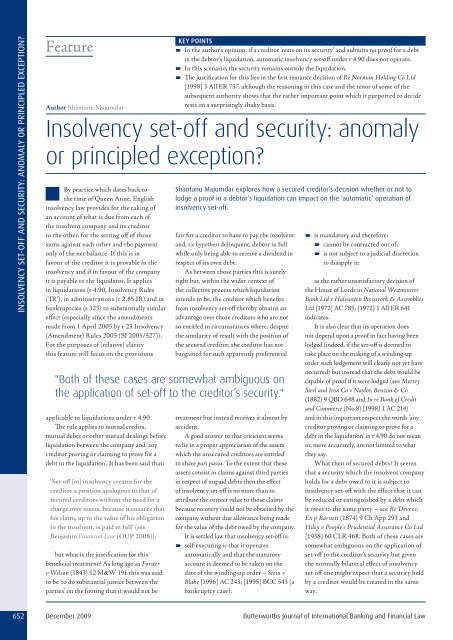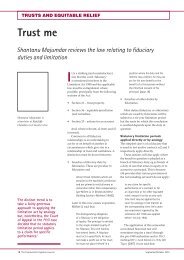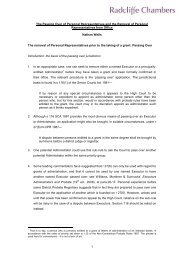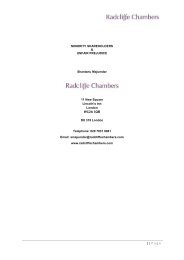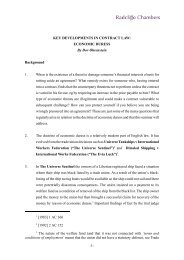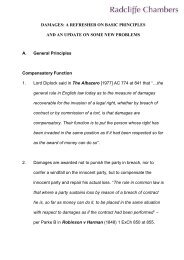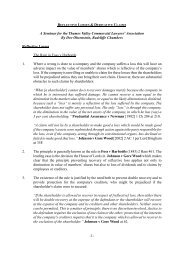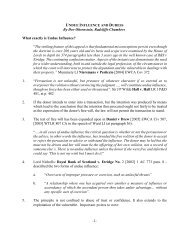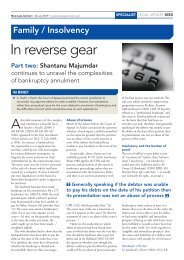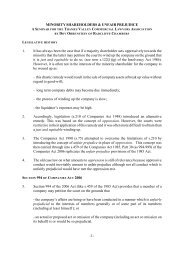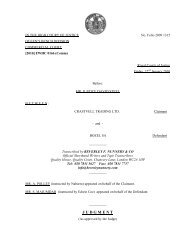Insolvency set-off and security - Radcliffe Chambers
Insolvency set-off and security - Radcliffe Chambers
Insolvency set-off and security - Radcliffe Chambers
You also want an ePaper? Increase the reach of your titles
YUMPU automatically turns print PDFs into web optimized ePapers that Google loves.
INSOLVENCY SET-OFF AND SECURITY: ANOMALY OR PRINCIPLED EXCEPTION?<br />
Feature<br />
Author Shantanu Majumdar<br />
<strong>Insolvency</strong> <strong>set</strong>-<strong>off</strong> <strong>and</strong> <strong>security</strong>: anomaly<br />
or principled exception?<br />
By practice which dates back to<br />
the time of Queen Anne, English<br />
insolvency law provides for the taking of<br />
an account of what is due from each of<br />
the insolvent company <strong>and</strong> its creditor<br />
to the other, for the <strong>set</strong>ting <strong>off</strong> of those<br />
sums against each other <strong>and</strong> the payment<br />
only of the net balance. If this is in<br />
favour of the creditor it is provable in the<br />
insolvency <strong>and</strong> if in favour of the company<br />
it is payable to the liquidator. It applies<br />
in liquidations (r 4.90, <strong>Insolvency</strong> Rules<br />
(‘IR’), in administrations (r 2.85 IR) <strong>and</strong> in<br />
bankruptcies (s 323) to substantially similar<br />
effect (especially since the amendments<br />
made from 1 April 2005 by r 23 <strong>Insolvency</strong><br />
(Amendment) Rules 2005 (SI 2005/527)).<br />
For the purposes of (relative) clarity<br />
this feature will focus on the provisions<br />
applicable to liquidations under r 4.90.<br />
The rule applies to mutual credits,<br />
mutual debts or other mutual dealings before<br />
liquidation between the company <strong>and</strong> ‘any<br />
creditor proving or claiming to prove for a<br />
debt in the liquidation’. It has been said that:<br />
‘Set-<strong>off</strong> [in] insolvency creates for the<br />
creditor a position analogous to that of<br />
secured creditors without the need for a<br />
charge over as<strong>set</strong>s, because it ensures that<br />
his claim, up to the value of his obligation<br />
to the insolvent, is paid in full’ (see<br />
Benjamin Financial Law (OUP 2008)).<br />
but what is the justification for this<br />
beneficial treatment? As long ago as Forster<br />
v Wilson (1843) 12 M&W 191 this was said<br />
to be ‘to do substantial justice between the<br />
parties’ on the footing that it would not be<br />
fair for a creditor to have to pay the insolvent<br />
<strong>and</strong>, ex hypothesi delinquent, debtor in full<br />
while only being able to receive a dividend in<br />
respect of its own debt.<br />
As between those parties this is surely<br />
right but, within the wider context of<br />
the collective process which liquidation<br />
intends to be, the creditor which benefits<br />
from insolvency <strong>set</strong>-<strong>off</strong> thereby obtains an<br />
advantage over those creditors who are not<br />
so entitled in circumstances where, despite<br />
the similarity of result with the position of<br />
the secured creditor, the creditor has not<br />
bargained for such apparently preferential<br />
"Both of these cases are somewhat ambiguous on<br />
the application of <strong>set</strong>-<strong>off</strong> to the creditor’s <strong>security</strong>."<br />
KEY POINTS<br />
In the author’s opinion, if a creditor ‘rests on its <strong>security</strong>’ <strong>and</strong> submits no proof for a debt<br />
in the debtor’s liquidation, automatic insolvency <strong>set</strong>-<strong>off</strong> under r 4.90 does not operate.<br />
In this scenario, the <strong>security</strong> remains outside the liquidation.<br />
The justification for this lies in the first instance decision of Re Norman Holding Co Ltd<br />
[1990] 3 All ER 757, although the reasoning in this case <strong>and</strong> the tenor of some of the<br />
subsequent authority shows that the rather important point which it purported to decide<br />
rests on a surprisingly shaky basis.<br />
Shantanu Majumdar explores how a secured creditor’s decision whether or not to<br />
lodge a proof in a debtor’s liquidation can impact on the ‘automatic’ operation of<br />
insolvency <strong>set</strong>-<strong>off</strong>.<br />
treatment but instead receives it almost by<br />
accident.<br />
A good answer to that criticism seems<br />
to lie in a proper appreciation of the as<strong>set</strong>s<br />
which the unsecured creditors are entitled<br />
to share pari passu. To the extent that these<br />
as<strong>set</strong>s consist in claims against third parties<br />
in respect of unpaid debts then the effect<br />
of insolvency <strong>set</strong>-<strong>off</strong> is no more than to<br />
attribute the correct value to those claims<br />
because recovery could not be obtained by the<br />
company without due allowance being made<br />
for the value of the debt owed by the company.<br />
It is <strong>set</strong>tled law that insolvency <strong>set</strong>-<strong>off</strong> is:<br />
self-executing ie that it operates<br />
automatically <strong>and</strong> that the statutory<br />
account is deemed to be taken on the<br />
date of the winding-up order – Stein v<br />
Blake [1996] AC 243; [1995] BCC 543 (a<br />
bankruptcy case);<br />
is m<strong>and</strong>atory <strong>and</strong> therefore:<br />
cannot be contracted out of;<br />
is not subject to a judicial discretion<br />
to disapply it;<br />
as the rather unsatisfactory decision of<br />
the House of Lords in National Westminster<br />
Bank Ltd v Halesowen Presswork & Assemblies<br />
Ltd [1972] AC 785; [1972] 1 All ER 641<br />
indicates.<br />
It is also clear that its operation does<br />
not depend upon a proof in fact having been<br />
lodged (indeed, if the <strong>set</strong>-<strong>off</strong> is deemed to<br />
take place on the making of a winding-up<br />
order such lodgement will clearly not yet have<br />
occurred) but instead that the debt would be<br />
capable of proof if it were lodged (see Mersey<br />
Steel <strong>and</strong> Iron Co v Naylor, Benzon & Co<br />
(1882) 9 QBD 648 <strong>and</strong> In re Bank of Credit<br />
<strong>and</strong> Commerce (No 8) [1998] 1 AC 214)<br />
<strong>and</strong> in this important respect the words ‘any<br />
creditor proving or claiming to prove for a<br />
debt in the liquidation’ in r 4.90 do not mean<br />
or, more accurately, are not limited to what<br />
they say.<br />
What then of secured debts? It seems<br />
that a <strong>security</strong> which the insolvent company<br />
holds for a debt owed to it is subject to<br />
insolvency <strong>set</strong>-<strong>off</strong> with the effect that it can<br />
be reduced or extinguished by a debt which<br />
it owes to the same party – see Re Deveze,<br />
Ex p Barnett (1874) 9 Ch App 293 <strong>and</strong><br />
Hiley v People’s Prudential Assurance Co Ltd<br />
[1938] 60 CLR 468. Both of these cases are<br />
somewhat ambiguous on the application of<br />
<strong>set</strong>-<strong>off</strong> to the creditor’s <strong>security</strong> but given<br />
the normally bilateral effect of insolvency<br />
<strong>set</strong>-<strong>off</strong> one might expect that a <strong>security</strong> held<br />
by a creditor would be treated in the same<br />
way.<br />
652<br />
December 2009<br />
Butterworths Journal of International Banking <strong>and</strong> Financial Law
However, Re Norman Holding Co Ltd<br />
[1990] 3 All ER 757, [1991] BCLC 1, a<br />
brief first instance decision determining a<br />
preliminary issue, holds otherwise. There,<br />
Mervyn Davies J considered that the wording<br />
of r 4.90 was unclear <strong>and</strong> that there was no<br />
clear authority on the question. The relevant<br />
assumed facts were:<br />
that the creditor was owed £400,000,<br />
for which it had <strong>security</strong> in the form of a<br />
charge, <strong>and</strong> upon which it was continuing<br />
to rely <strong>and</strong> in respect of which it had<br />
(therefore) submitted no proof;<br />
that it was owed a further unsecured sum<br />
in respect of which it had submitted a<br />
proof;<br />
that the creditor owed a sum to the<br />
insolvent company in respect of its breach<br />
of a contract.<br />
It was common ground that there had<br />
been mutual dealings between the company<br />
<strong>and</strong> creditor within the meaning of the rule.<br />
The judge rejected (it is submitted correctly)<br />
the contention that by proving in respect of<br />
the unsecured debt the creditor had brought<br />
insolvency <strong>set</strong>-<strong>off</strong> into play in relation to all<br />
of the sums which were owed to it (ie the<br />
secured as well as unsecured). Although<br />
the judge thought that this was an available<br />
interpretation of the language of the rule,<br />
he distinguished between debts which were<br />
in (unsecured) <strong>and</strong> outside (secured) the<br />
liquidation:<br />
‘As a secured creditor he does not (unless<br />
he so elects) prove or claim to prove for<br />
his debt in the liquidation. He relies<br />
on <strong>and</strong> realises his <strong>security</strong>. But as an<br />
unsecured creditor he proves in the<br />
liquidation <strong>and</strong> so is caught by <strong>set</strong>-<strong>off</strong> as to<br />
the unsecured debt. Thus I read r 4.90 as<br />
affecting debts proved in the liquidation<br />
<strong>and</strong> not as affecting debts that are elected<br />
not to be proved therein.’<br />
The judge went on to hold, without further<br />
reasoning but ‘with some hesitation’, that:<br />
‘... while r 4.90 <strong>set</strong>-<strong>off</strong> applies to an<br />
unsecured creditor who proves in the<br />
liquidation, that creditor is not obliged<br />
to bring into account any secured debt<br />
owing to him by the insolvent company<br />
if the secured debt is not proved in the<br />
liquidation. As I have said, r 4.90 affects<br />
debts proved in the liquidation but does not<br />
affect debts that are elected not to be proved.’<br />
[emphasis added]<br />
But why is this so? A little earlier in<br />
his judgment the judge had identified the<br />
submission (in reliance upon Re Daintry, ex<br />
p Mant [1900] 1 QB 546 at 568, [1895-9]<br />
All ER Rep 657 at 670-671) that a creditor<br />
claiming to prove a debt is (or includes) a<br />
creditor who has a right to prove a debt <strong>and</strong><br />
therefore that since a secured creditor has a<br />
right to prove it is ‘claiming to prove’ within<br />
the meaning of r 4.90. The judge rejected that<br />
submission: ‘No doubt [the creditor] has a<br />
right to elect to prove for its secured debt but<br />
it is choosing not to do so.’<br />
It is unclear whether the judge is there<br />
accepting that a secured debt is provable but,<br />
if it is, then, as indicated earlier in this feature,<br />
the law before as well as since Re Norman is<br />
that having a provable debt is sufficient to fulfil<br />
the requirement of ‘claiming to prove’ <strong>and</strong><br />
therefore that insolvency <strong>set</strong>-<strong>off</strong> applies even<br />
though the creditor has not (yet) chosen to<br />
prove. To the extent, therefore, that the judge’s<br />
reasoning seems to rest on the (mere) choice<br />
of the creditor it is insufficient since this does<br />
not prevent the operation of <strong>set</strong>-<strong>off</strong> in relation<br />
to an unsecured debt even where the creditor<br />
deliberately delays in lodging its proof.<br />
So what is special or different about a<br />
secured debt? A secured creditor has four<br />
choices open to it:<br />
it can ab<strong>and</strong>on its <strong>security</strong> <strong>and</strong> prove for<br />
the whole of the debt due;<br />
it can value its <strong>security</strong> in its proof <strong>and</strong><br />
prove for the deficiency;<br />
it can enforce its <strong>security</strong> <strong>and</strong> prove for<br />
any shortfall; <strong>and</strong><br />
it can ‘rest on its <strong>security</strong>’ <strong>and</strong> submit no<br />
proof.<br />
Feature<br />
Which of these options it will take<br />
will obviously depend on the particular<br />
circumstances but it is equally obvious that,<br />
even on the footing that the decision to submit<br />
a proof is the trigger for the application of<br />
<strong>set</strong>-<strong>off</strong> in the case of a secured debt, three of<br />
these four options have that effect to varying<br />
degrees.<br />
Yet why not the fourth? Is it because<br />
without the submission of a proof it is not<br />
provable? The difficulty with that bald<br />
proposition is that a debt in respect of which<br />
a proof could be submitted must in one sense<br />
ipso facto be provable. As Lord H<strong>off</strong>mann<br />
put it in (the subsequent decision in) Stein v<br />
Blake a creditor ‘claiming to prove’ means:<br />
‘any creditor of the bankrupt who [but for<br />
insolvency <strong>set</strong>-<strong>off</strong>] would have been entitled<br />
"[The judge] distinguished between debts which were<br />
in (unsecured) <strong>and</strong> outside (secured) the liquidation."<br />
to prove for a ... debt’ (at [1995] 2 All ER 961<br />
at 966).<br />
Why does this (indeed how can it) not<br />
apply to a secured creditor who is entitled to<br />
do any (or at least three) of the things above?<br />
In Stein v Blake, Re Norman was cited<br />
in the printed cases of the parties but no<br />
reference was made to it in the judgments.<br />
This was the platform from which it was<br />
submitted in Stewart v Scottish Widows <strong>and</strong><br />
Life Assurance Society plc [2005] All ER (D)<br />
247 (Jun) that it could be taken impliedly to<br />
have been overruled by the decision in Stein.<br />
The judge in Stewart thought otherwise but,<br />
although he was correct to identify that the<br />
central issue in Stein was whether the original<br />
choses in action comprising the claims giving<br />
rise to the debts survived the operation<br />
of insolvency <strong>set</strong>-<strong>off</strong> (they did not), it is<br />
submitted that he does not sufficiently explain<br />
how Re Norman with its exclusive emphasis<br />
on the voluntary conduct of the creditor (to<br />
prove or not to prove) can be reconciled with<br />
what Lord H<strong>off</strong>mann says in Stein about the<br />
m<strong>and</strong>atory <strong>and</strong> automatic nature of insolvency<br />
<strong>set</strong>-<strong>off</strong>. Indeed, the timing of the deemed<br />
taking of the statutory account – at the date<br />
of the winding-up order – might be thought<br />
INSOLVENCY SET-OFF AND SECURITY: ANOMALY OR PRINCIPLED EXCEPTION?<br />
Butterworths Journal of International Banking <strong>and</strong> Financial Law December 2009 653
INSOLVENCY SET-OFF AND SECURITY: ANOMALY OR PRINCIPLED EXCEPTION?<br />
Feature<br />
to be consistent with a <strong>set</strong>-<strong>off</strong> which preempts<br />
whatever decision the secured (as well<br />
as unsecured) creditor might subsequently<br />
make about proof.<br />
In MS Fashions Ltd v Bank of Credit <strong>and</strong><br />
Commerce International SA (in liquidation)<br />
(No 2) [1993] 3 All ER 769 Dillon LJ said<br />
that:<br />
‘If there are indeed mutual credits<br />
or mutual debts or mutual dealings<br />
between a company, or a bankrupt<br />
<strong>and</strong> a creditor, then the <strong>set</strong>-<strong>off</strong> applies<br />
notwithst<strong>and</strong>ing that one or other of the<br />
debts or credits may be secured.’<br />
In so saying, Dillon LJ relied upon<br />
Re Deveze <strong>and</strong> Hiley which, as has been<br />
mentioned, are somewhat ambiguous on<br />
the point but his reference to ‘one or other<br />
of the debts or credits’ being secured seems<br />
plainly to include a secured debt owed to<br />
the creditor. (MS Fashions is not mentioned<br />
by the judge in Stewart <strong>and</strong> it is not clear<br />
whether it was cited to the court.)<br />
In BCCI (No 8) in the Court of Appeal<br />
([1996] 2 All ER 121) Rose LJ referred<br />
to ‘trust property <strong>and</strong> <strong>security</strong>’ st<strong>and</strong>ing<br />
‘outside the scheme of distribution <strong>and</strong> the<br />
scope of insolvency <strong>set</strong>-<strong>off</strong>’ but this point was<br />
not mentioned by the House of Lords in its<br />
judgment on the appeal <strong>and</strong> the position now<br />
<strong>and</strong> for some time has been an unsatisfactory<br />
one. Re Norman seems generally accepted<br />
to be the law but both the reasoning in that<br />
case <strong>and</strong> the tenor of some of the subsequent<br />
authority shows that the rather important<br />
point which it purported to decide rests on<br />
a surprisingly shaky basis, at least so far as<br />
express reasoning is concerned.<br />
It is submitted that what was said in Re<br />
Norman <strong>and</strong> elsewhere on the relationship<br />
between insolvency <strong>set</strong>-<strong>off</strong> <strong>and</strong> secured<br />
debts is pregnant with certain assumptions<br />
which are insufficiently expressed but which<br />
are capable of explaining the exceptional<br />
treatment accorded to secured creditors<br />
under r 4.90. These assumptions proceed<br />
from the special status accorded to <strong>security</strong><br />
interests in English law. It has been said (see<br />
Goode Principles of Corporate <strong>Insolvency</strong> Law<br />
(Sweet & Maxwell, 3rd Ed 2005) that the<br />
policy justification for upholding <strong>security</strong><br />
interests is simply that the relevant creditor<br />
has bargained for the priority which it gives<br />
him <strong>and</strong> that in those circumstances (<strong>and</strong><br />
so long as there is no unfair preference <strong>and</strong><br />
other creditors have notice of the <strong>security</strong>)<br />
the unsecured cannot legitimately complain.<br />
Policy apart, the juridical basis of that<br />
beneficial treatment is that <strong>security</strong> interests<br />
are property interests <strong>and</strong>, in English law,<br />
property interests trump merely personal<br />
interests. In the context of insolvency<br />
"This conceptual recognition that <strong>security</strong> <strong>and</strong> proof<br />
are incompatible lies at the heart of the matter."<br />
Biog box<br />
Shantanu Majumdar is a barrister at <strong>Radcliffe</strong> <strong>Chambers</strong> in Lincoln’s Inn.<br />
Email: smajumdar@radcliffechambers.com<br />
secured as<strong>set</strong>s simply do not, to the extent<br />
of the <strong>security</strong>, form part of the as<strong>set</strong>s of the<br />
company available for distribution <strong>and</strong> the<br />
entitlement of the <strong>security</strong> holder to st<strong>and</strong><br />
outside the winding up (see Sowman v David<br />
Samuel Trust Ltd [1978] 1 All ER 616) then<br />
seems to follow, ineluctably.<br />
This point was starkly made by James<br />
LJ in Re David Lloyd & Co (1877) 6 Ch D<br />
339 (at 344) in the slightly different context<br />
of a mortgagee seeking the permission of<br />
the court to enforce his mortgage against an<br />
insolvent company:<br />
‘But [the purpose of the requirement for<br />
leave] has really nothing to do with the<br />
case of a man who for present purposes<br />
is to be considered as entirely outside<br />
the company, who is seeking to enforce<br />
a claim, not against the company, but<br />
to his own property. The position of a<br />
mortgagee under such circumstances is,<br />
to my mind, exactly similar to that of a<br />
man who said, “You the company have<br />
got property which you have taken from<br />
me, you are in possession of my property<br />
by way of trespass <strong>and</strong> I want to get it<br />
back again”.’<br />
As James LJ then went on to say:<br />
‘The mortgagee says “There is some<br />
property upon which I have a certain<br />
specific charge, <strong>and</strong> I want to realise<br />
that charge. I have nothing to do with<br />
the distribution of your property among<br />
your creditors, this is my property”.’<br />
That being so, Re Norman Holding<br />
becomes easier both to underst<strong>and</strong> <strong>and</strong> to<br />
justify. The choice whether <strong>and</strong> when to<br />
prove in respect of a secured debt is not a<br />
decision about when to prove for a provable<br />
debt (to which <strong>set</strong>-<strong>off</strong> would automatically<br />
have applied) but instead a decision<br />
about whether a debt which is outside the<br />
company’s as<strong>set</strong>s <strong>and</strong> their liquidation will<br />
become at least to some extent provable <strong>and</strong><br />
thereby subject to <strong>set</strong>-<strong>off</strong>. This will occur<br />
if, but only if, the creditor takes one of the<br />
first three of the courses of action open to it<br />
<strong>and</strong> listed earlier in this feature <strong>and</strong> which<br />
fundamentally depend upon proving what is<br />
not (or, in the case of surrender, no longer)<br />
secured.<br />
It is possible then to discern that when<br />
Mervyn Davies J said: ‘[n]o doubt [the<br />
creditor] has a right to elect to prove for its<br />
secured debt but it is choosing not to do so'<br />
the words ‘to elect’ make all the difference.<br />
This conceptual recognition that <strong>security</strong><br />
<strong>and</strong> proof are incompatible lies at the heart<br />
of the matter <strong>and</strong> the fact that one of the<br />
things which – in the nature of <strong>security</strong> – the<br />
creditor has bargained for is the right not to<br />
rely on its <strong>security</strong> is nothing to the point.<br />
If it does nothing (‘rests on its <strong>security</strong>’)<br />
then the <strong>security</strong> remains <strong>and</strong> it <strong>and</strong> the<br />
creditor remain outside the liquidation. As<br />
Lord H<strong>off</strong>mann said in Re BCCI (No 8) the<br />
secured creditor is not obliged to prove <strong>and</strong> if<br />
it really is outside the liquidation then Rose<br />
LJ’s statement in his judgment in the Court<br />
of Appeal in the same case that ‘[s]et <strong>off</strong><br />
ought not to prejudice the right of a secured<br />
creditor to enforce his securities in any order<br />
he chooses <strong>and</strong> at a time of his choice’ is no<br />
more than obvious.<br />
•<br />
654<br />
December 2009<br />
Butterworths Journal of International Banking <strong>and</strong> Financial Law


